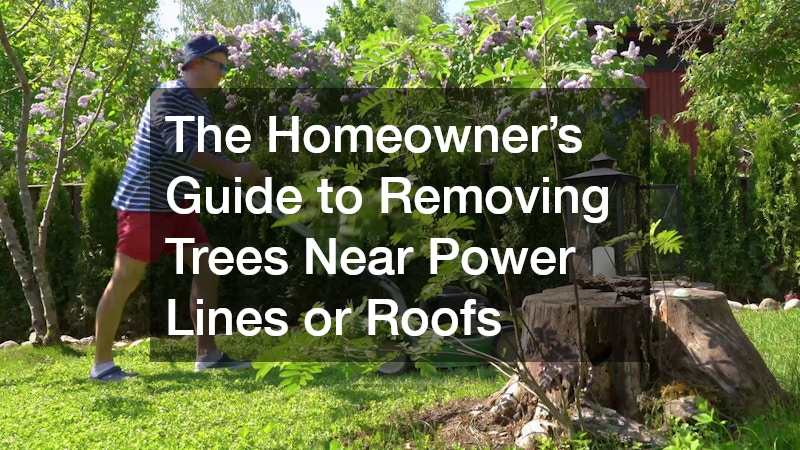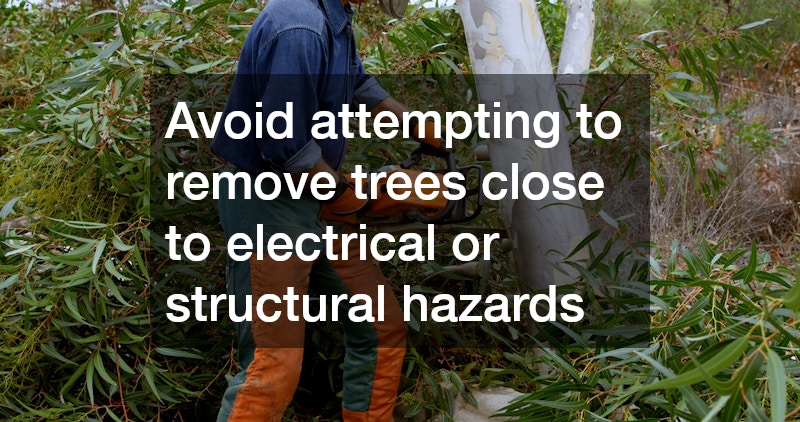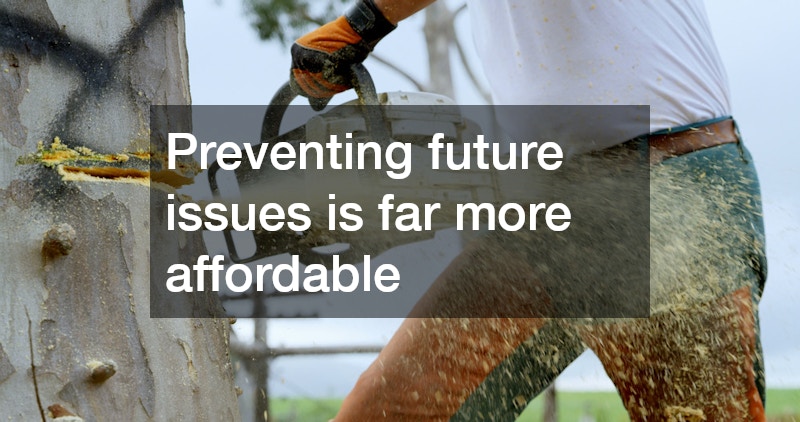
Key Takeaways
-
Trees near power lines or roofs can cause fires, outages, and property damage.
-
DIY removal is extremely risky due to electrocution and structural hazards.
-
Always coordinate with your utility company before any removal.
-
Hire certified, insured arborists experienced with hazardous jobs.
-
Prevent future problems through routine trimming and careful tree selection.

Removing a tree may seem like a straightforward task, but when it’s located near power lines or your roof, it becomes one of the most dangerous home improvement projects a homeowner can face. A single wrong cut or misjudged angle can cause power outages, roof damage, or even severe injury. That’s why tree removal near utility lines or residential structures requires precision, experience, and the right equipment.
This guide explains what homeowners need to know before taking any action—covering safety hazards, legal concerns, removal techniques, and how to choose qualified professionals for the job.
Understanding the Risks of Trees Near Power Lines and Roofs
Trees that grow too close to structures or power sources can cause significant problems. Beyond cosmetic concerns or blocked sunlight, they pose real safety threats to both your home and the electrical grid.
Electrical and Fire Hazards
-
Branches brushing against power lines can cause electrical arcing—sparks that can ignite fires or damage equipment.
-
Wet branches conduct electricity, increasing the risk of shock during storms or trimming.
-
Even without direct contact, voltage can arc several inches through the air, meaning a branch that appears clear of a wire might still be dangerous.
-
Fallen limbs during wind or ice storms can tear down lines and cut off service for entire neighborhoods.
Structural Damage to Roofs
-
Overhanging branches can scrape shingles and gutters, wearing away protective coatings over time.
-
Large limbs may break off in storms and puncture roofing materials or skylights.
-
Tree roots can extend beneath driveways or foundations, causing cracks and uneven settling.
-
Accumulated leaves and debris clog gutters, leading to water pooling and roof leaks.
Environmental and Liability Risks
-
Improperly removed trees can damage surrounding vegetation or nearby structures.
-
A falling branch that hits a neighbor’s fence, car, or roof can make the homeowner liable for damages.
-
In some areas, removing trees without permits can lead to fines or community violations.
When a Tree Becomes a Safety Concern
Recognizing warning signs early allows you to address the problem before it escalates into a major hazard.
Key Warning Signs
-
Branches within 10 feet of power lines—this is generally considered the minimum clearance for safety.
-
Leaning trunks directed toward your roof or utility lines.
-
Dead or decaying branches that frequently drop twigs or debris.
-
Hollow trunks or root rot that compromise stability.
-
Rapid canopy thinning—a sign the tree may be dying or structurally unsound.
Seasonal Considerations
-
The dormant season (late fall through early spring) is often ideal for removals since trees are lighter and easier to handle.
-
Avoid waiting until storm season; heavy winds can make dangerous trees unpredictable and increase removal difficulty.

Legal and Utility Considerations
Tree removal near power lines involves more than just technical skill—it often includes coordination with local authorities and utility providers.
Responsibility and Jurisdiction
-
Utility-owned trees: Trees growing near public lines are usually maintained by the power company. Homeowners should report issues rather than attempting removal themselves.
-
Service drop lines (the lines that connect poles to your house) may fall under homeowner responsibility. In such cases, hiring an insured professional is essential.
Permits and Local Regulations
-
Many cities require a tree removal permit, especially for large or protected species.
-
Working within utility easements without authorization can result in penalties.
-
Certain municipalities restrict removal of healthy, mature trees unless they pose an imminent safety risk.
Working with Utility Companies
-
Always notify the utility company if the tree touches or threatens power lines.
-
The company may temporarily disconnect service or assign a crew to assist.
-
Never attempt to prune or cut limbs that are within reach of energized wires—this must be handled by certified professionals.
How Professionals Handle Tree Removal Near Power Lines and Roofs
Professional tree removal is a calculated, multi-step process designed to ensure safety, efficiency, and minimal disruption.
1. Initial Site Assessment
-
Certified arborists evaluate tree size, location, lean, and structural condition.
-
They identify hazards such as brittle wood, decay, or hidden electrical lines.
-
A detailed removal plan is created, often with input from both the homeowner and utility representatives.
2. Use of Specialized Equipment
Because working near power sources or roofs demands precision, professional crews rely on advanced tools such as:
-
Aerial lifts or bucket trucks to reach high or unstable branches.
-
Rigging systems and ropes that control the direction of falling limbs.
-
Cranes to lift and section large trees piece by piece without allowing them to fall freely.
-
Protective barriers and mats to safeguard lawns, driveways, and structures.
This methodical approach ensures each segment of the tree is removed under control, rather than relying on unpredictable cuts or drops. And while the use of cranes may drive up the price of the project, it is absolutely required for safety, particularly in situations where the tree is too large, unstable, or positioned over power lines, roofs, or other structures that make traditional cutting and felling impossible without risking severe property damage or injury.
Multiple factors affect the cost of hiring a crane, and whether you’ll be looking at short- or long-term rentals:
-
Type and Size of Crane Needed: Larger cranes with higher lifting capacities cost more to rent.
-
Duration of Rental: Longer rental periods increase overall expenses, including operator fees.
-
Location and Accessibility: Difficult-to-access sites or urban areas with limited space may require specialized equipment or permits, raising costs.
-
Setup and Mobilization: Transporting, assembling, and dismantling the crane adds to the total price.
-
Load Weight and Reach: Heavier loads and longer reach requirements demand more powerful cranes, which are pricier.
-
Operator Expertise and Labor Costs: Skilled operators and additional crew members influence hourly or daily rates.
-
Permits and Insurance: Obtaining necessary permits and insurance coverage can add administrative fees.
-
Project Complexity and Safety Requirements: Jobs involving delicate maneuvering near power lines or structures require extra precautions, increasing cost.
3. Controlled Cutting and Sectioning
-
Large branches are cut incrementally from top to bottom.
-
Workers secure each section with ropes to prevent swinging into wires or roofs.
-
Ground crew members coordinate with climbers to ensure debris lands safely away from property.
-
Precision saws and hydraulic cutters allow for minimal vibration or splintering near delicate structures.
4. Cleanup and Disposal
-
Wood and debris are removed immediately to prevent hazards.
-
Many services offer stump grinding or wood recycling options.
-
Reputable companies restore the area to its pre-work condition, including raking and sweeping the workspace.
Why DIY Tree Removal Near Power Lines Is Never Worth the Risk
Even homeowners comfortable with power tools should avoid attempting to remove trees close to electrical or structural hazards.
Severe Safety Risks
-
Electrical current can jump from wires to tools or branches unexpectedly.
-
Ladder use near lines increases the chance of contact or falls.
-
One misjudged cut can send a branch crashing onto a roof, vehicle, or even a neighbor’s property.
Lack of Proper Equipment
-
Home-grade chainsaws, ladders, and ropes are not rated for high-tension or overhead work.
-
Professionals use insulated equipment, helmets, harnesses, and grounding systems that most homeowners don’t possess.
Hidden Costs of DIY Attempts
-
Repairing a damaged roof or replacing downed lines can cost thousands more than hiring professionals initially.
-
Insurance may not cover accidents caused by unlicensed or unauthorized tree removal.
In short, what looks like saving money up front can quickly turn into a costly—and dangerous—mistake.
How to Choose the Right Tree Removal Service
Selecting the right company makes all the difference between a seamless project and a potential nightmare.
Certification and Insurance
Look for the following qualifications:
-
ISA (International Society of Arboriculture) certification—proof the arborist meets industry standards.
-
Proof of liability and worker’s compensation insurance—protects you if an accident occurs.
-
Local business license and good standing with utility providers if working near lines.
Experience with Hazardous Removals
Ask potential contractors these questions:
-
Have you handled removals within 10 feet of live lines or near residential roofs?
-
What safety protocols do you follow to protect structures and utilities?
-
Will you coordinate with the power company if necessary?
Equipment Capability and Techniques
A reliable tree service should have:
-
Access to cranes, aerial lifts, or advanced rigging systems.
-
Staff trained in controlled dismantling rather than simple felling.
-
Clear communication about how debris will be handled or disposed of.
Getting a Detailed Estimate
A professional quote should outline:
-
Site inspection results and identified hazards.
-
Required permits or utility coordination.
-
Estimated labor time and equipment use.
-
Cleanup and disposal details.
Avoid any contractor who offers a flat price without seeing the site or refuses to provide proof of insurance.
Preventive Tree Maintenance Around Power Lines and Roofs
Preventing future issues is far more affordable—and less stressful—than emergency removals.
Regular Trimming and Inspection
-
Schedule trimming every 1–3 years depending on tree species and growth rate.
-
Hire certified arborists for trees near utility lines to maintain proper clearance.
-
Inspect after major storms for broken or weakened branches.
Choosing the Right Tree Species
If you’re planting new trees near your home:
-
Select low-growing species such as dogwood, crape myrtle, or redbud that won’t reach utility lines.
-
Avoid fast-growing, brittle trees like silver maples or cottonwoods near structures.
-
Leave adequate spacing—at least 15–20 feet from buildings or power sources for small trees, and 30–50 feet for large species.
Storm Preparation and Emergency Response
-
If a tree falls on or near a power line, stay away and call the utility company immediately.
-
Do not attempt to move limbs yourself; electricity can travel through the wood.
-
For trees leaning dangerously after storms, call an emergency removal service equipped for high-risk conditions.
Cost Considerations for Tree Removal Near Power Lines
Tree removal costs vary widely, but understanding the factors behind pricing helps homeowners budget realistically.
Factors That Influence Price
-
Tree size and location—larger or taller trees near wires cost more due to complexity.
-
Accessibility—tight backyards or sloped terrain may require specialized equipment.
-
Proximity to hazards—working near live lines or roofs increases labor and safety requirements.
-
Disposal options—stump grinding, hauling, or wood recycling add to total cost.
-
Permits or coordination fees—some cities charge for inspections or temporary power shutoffs.
Typical Cost Ranges
-
Small trees under 25 feet: $200–$500
-
Medium trees (25–60 feet): $500–$1,500
-
Large trees near hazards or structures: $1,500–$3,000+
-
Emergency or storm-related removals may exceed these ranges depending on urgency and risk level.
Why the Lowest Bid Isn’t Always Best
-
Unqualified contractors may skip safety protocols or lack insurance.
-
Damage caused by poor workmanship can void homeowner’s insurance or cost thousands to repair.
-
Professional crews use certified methods and equipment that justify the higher price tag for peace of mind.
Removing trees near power lines or roofs is not a project that belongs on a weekend to-do list. It involves electrical hazards, property risks, and legal considerations that demand professional expertise.
By understanding the warning signs, working with your local utility provider, and hiring certified tree removal specialists, you can protect your home while keeping your property safe and compliant. Regular inspections and smart planting choices will also help prevent future hazards—saving time, money, and worry in the long run.
When in doubt, always choose safety over shortcuts. The right professionals can ensure your tree removal is handled with precision, protecting both your home and everyone around it.

